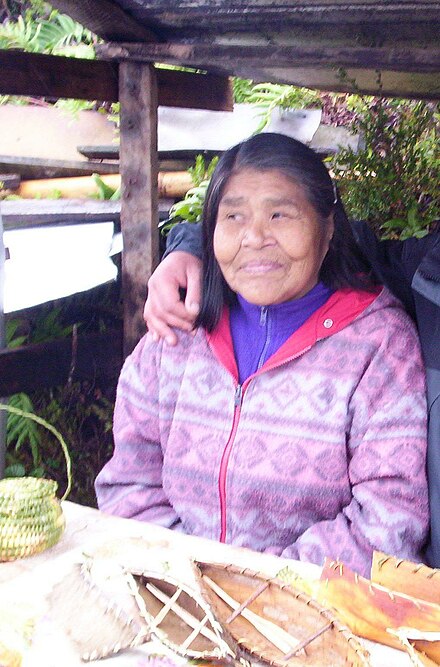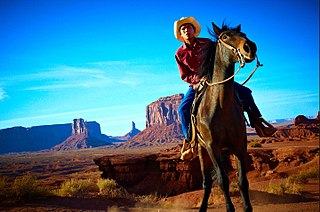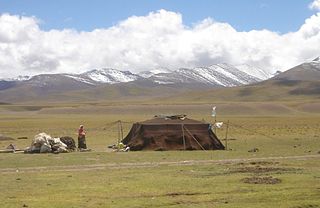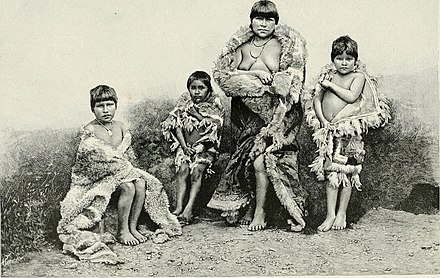
Tierra del Fuego is an archipelago off the southernmost tip of the South American mainland, across the Strait of Magellan. The archipelago consists of the main island, Isla Grande de Tierra del Fuego, with an area of 48,100 km2 (18,572 sq mi), and a group of many islands, including Cape Horn and Diego Ramírez Islands. Tierra del Fuego is divided between Chile and Argentina, with the latter controlling the eastern half of the main island and the former the western half plus the islands south of Beagle Channel. The southernmost extent of the archipelago is at about latitude 55 S.
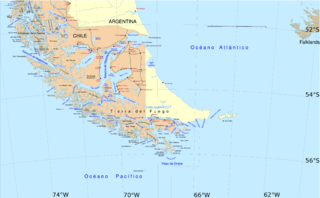
The Strait of Magellan, also called the Straits of Magellan, is a navigable sea route in southern Chile separating mainland South America to the north and Tierra del Fuego to the south. The strait is the most important natural passage between the Atlantic and Pacific oceans.
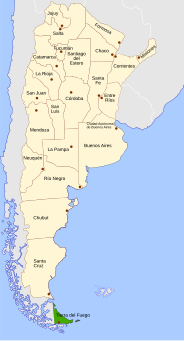
Tierra del Fuego is an Argentine province.

The Selk'nam, also known as the Onawo or Ona people, are an indigenous people in the Patagonian region of southern Argentina and Chile, including the Tierra del Fuego islands. They were one of the last native groups in South America to be encountered by migrant ethnic Europeans or Westerners in the late 19th century.

The Yaghan, also called Yagán, Yahgan, Yámana, Yamana or Tequenica, are one of the indigenous peoples of the Southern Cone, who are regarded as the southernmost peoples in the world. Their traditional territory includes the islands south of Isla Grande de Tierra del Fuego, extending their presence into Cape Horn. They have been there for more than 10,000 years.
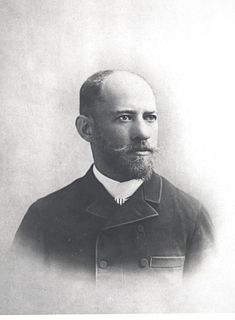
Julius Popper, also known in Spanish as Julio Popper, was a Romanian-born Argentine engineer, adventurer and explorer. He was the designer of the modern outline of the city of Havana, Cuba.
Kawésqar (Qawasqar), also known as Alacaluf, is a critically endangered language isolate spoken in southern Chile by the Kawésqar people. Originally part of a small family, only the northern language remains. Only 7 speakers of the language remain, most of them on Wellington Island off the southwestern coast of Chile.

Dawson Island is an island in the Strait of Magellan that forms part of the Tierra del Fuego archipelago, 100 km south of the city of Punta Arenas in Chile, and part of the Municipality of Punta Arenas. It is located southeast of Brunswick Peninsula. It is often lashed with harsh Antarctic weather. The settlements are Puerto Harris, Puerto San Antonio and Puerto Almeida.
Esteban Lucas Bridges was an Anglo-Argentine author, explorer, and rancher. After fighting for the British during World War I, he married and moved with his wife to South Africa, where they developed a ranch with her brother.
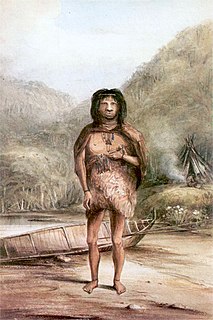
Fuegians are one of the three tribes of indigenous inhabitants of Tierra del Fuego, at the southern tip of South America. In English, the term originally referred to the Yaghan people of Tierra del Fuego. In Spanish, the term fueguino can refer to any person from the archipelago.
The Fuegian languages are the indigenous languages historically spoken in Tierra del Fuego by Native Americans. Adelaar lists the Fuegian languages as the Kawésqar language, the Ona language and the Yaghan language in addition to Chono, Gününa Yajich, and the Tehuelche language.

Aracena Island is an island in the Magallanes Region of Chile. It belongs to the Tierra del Fuego archipelago, and forms part of the Alberto de Agostini National Park.
Alberto Achacaz Walakial was a Chilean citizen and one of the last full-blooded Kaweskars, who are also known as the Alacaluf, or Halakwulup. The Kaweskar are an indigenous Native American people who were once found in coastal regions of Chilean Patagonia. There are estimated to be only approximately a dozen full-blooded Kaweskars still living following Achacaz's death in 2008. However, there are no Kaweskar women of fertile age remaining, so the tribe appears to be headed for extinction.

The Haush or Manek'enk were an indigenous people, considered the oldest inhabitants of Tierra del Fuego, who spoke the Haush language. Their autonym, or name for themselves was Manek'enk.
The Teushen language is an indigenous language of Argentina, which may be extinct. It was spoken by the Teushen people, a nomadic hunter-gatherer people of Patagonia, who lived between the Puelche people to their north and the Tehuelche people to the south, who occupied the central part of the Tierra del Fuego region. The tribe is now extinct.
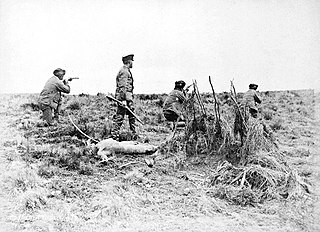
The Selk'nam genocide was the genocide of the Selk'nam people, one of three indigenous tribes populating the Tierra del Fuego in South America, from the second half of the 19th to the early 20th century. Spanning a period of between ten and fifteen years the Selk'nam, which had an estimated population of some three thousand, saw their numbers reduced to 500.
The Haush language was an indigenous language spoken by the Haush people and was formerly spoken on the island of Tierra del Fuego. The Haush were considered the oldest inhabitants of Tierra del Fuego; they inhabited the far eastern tip of the Mitre Peninsula on the island. They made regular hunting trips to Isla de los Estados.
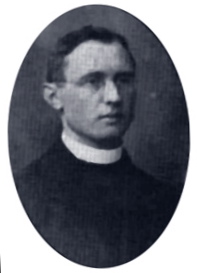
The Martin Gusinde Anthropological Museum is an anthropology museum in Puerto Williams, Isla Navarino, in southernmost Chile. It is the southernmost museum of the world. The museum hosts artifacts, maps and photographs related to the 10,000-year history of the Yahgan people, as well as European settlers since the 19th century. Samples of local flora and fauna are also displayed, as well as photographs and text from the founding of Puerto Williams.
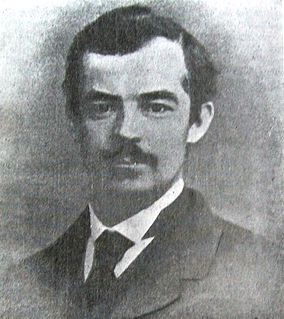
Thomas Bridges was an Anglican missionary and linguist, the first to set up a successful mission to the indigenous peoples in Tierra del Fuego, Argentina. Adopted and raised in England by George Pakenham Despard, he accompanied his father to Argentina with the Patagonian Missionary Society. After an attack by indigenous people, in 1869 Bridges' father, Despard, left the mission at Keppel Island of the Falkland Islands, to return with his family to England. At the age of 17, Bridges stayed with the mission as its new superintendent. In the late 1860s, he worked to set up a mission at what is now the town of Ushuaia along the southern shore of Tierra del Fuego Island.
